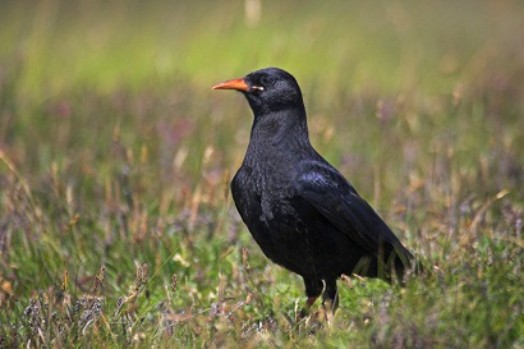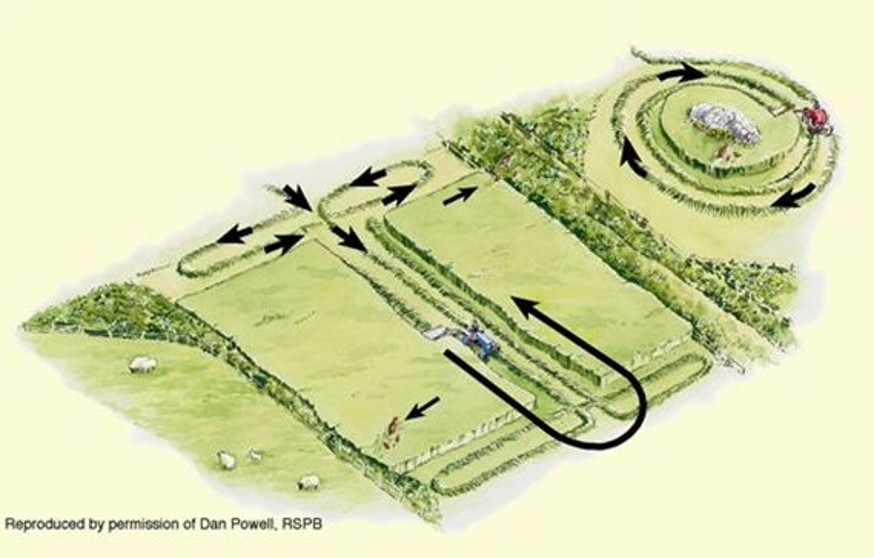Supporting guidance for Chough Mown Grassland
Date published: 3 October, 2023
For recent changes to this guidance, please see the bottom of the page.

Choughs are part of the crow family but with much more specialised habitat requirements than their near relations such as carrion crows, rooks and magpies.
To survive and breed successfully, chough need:
- nesting habitat on cliffs and in abandoned buildings
- access to year-round short vegetation and livestock dung in which to find their insect food
- silage / hay aftermath in which to find their insect food during chick rearing
The Chough Grazing Management option provides both the short vegetation and the silage / hay aftermath required for chough feeding and chick rearing.
Choughs prefer to forage in short-grazed, free-draining grassland and silage aftermath of between one and 10 centimetres in height, as this allows them access to the soil insects on which they feed.
Hay and silage crops are especially beneficial where cutting dates are staggered to extend the period when a freshly-cut crop is available. Where possible, you can also apply an early cut under the Chough Grazing Management option in combination with a later cut under the Chough Mown Grassland option to maximise the benefit to chough.
This option provides short-grazed grass early in the season, and a later-season silage aftermath.
Where to locate your chough mown grassland
To give best results fields should be close to communal roosts and within one kilometre of nest sites traditionally used by family groups and fledglings.
What you are trying to achieve
- Before late June (during the chick rearing period)
Some permanently grazed grassland within one kilometre of nest sites
- After late June (once chicks have fledged)
Both short pasture and rolling availability of silage aftermath (for this option it is late availability, cutting after 15 August ) close to communal family roosts

Wildlife-friendly mowing
There is a chance that chosen fields will also contain ground-nesting birds. Mowing can destroy nests and kill chicks that are unable to fly. The late mowing date in this option should benefit ground-nesting birds as well as chough, as it delays the process until most nests have hatched and the majority of chicks will be large enough to escape the mower – if they have somewhere to go.
Mowing for this option should be carried out in a wildlife-friendly manner. Unless there is longer vegetation immediately adjacent to the field that you have been mowing towards then, if possible, leave a two metre uncut strip for birds to escape into.

How to increase the success of this option
This option works best when combined with other options that provide feeding and safe nesting sites for chough. This could include the Chough Grazing Management option and the Creation of Chough Nest Shelter capital item.
It is very important for the effectiveness of this option that Avermectin-based drugs are not used on stock, particularly at chough breeding and chick-rearing times. Chough rely heavily on dung invertebrates for feeding and these drugs reduce the number of insects within the dung. Use of these drugs must be at the recommendation of a vet and with NatureScot approval.
In order to increase food availability for chicks it is also important that there is a presence of dung for as long and sustained a period as possible. This allows new dung to be colonised by insects that are already present in older dung close by.
Other benefits of this option
Late cutting will benefit any ground-nesting birds in the field, in particular corncrake and skylark. Late cutting has also been shown to benefit plants including rare arable weeds, pollinating invertebrates, ground beetles, hares, spiders and wading birds. It is of general benefit to species richness and abundance.
Further information
Additional information about Avermectin-based drugs is available from your local vet and from the local NatureScot office.
